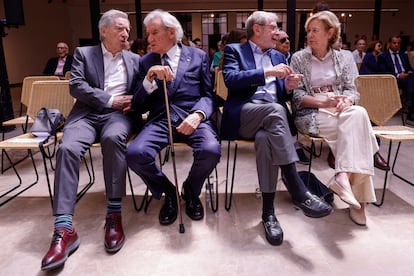Those who did not bow their heads

Strictly opinion pieces that reflect the author's own style. These opinion pieces must be based on verified data and be respectful of individuals, even if their actions are criticized. All opinion columns by individuals outside the EL PAÍS editorial team will include, after the last line, a byline—no matter how well-known—indicating the author's position, title, political affiliation (if applicable), or main occupation, or any that is or was related to the topic addressed.

At 14 Larra Street in Madrid, the editorial offices and printing presses were located where several magazines and newspapers were published before the Civil War, which today have a legendary resonance in the history of journalism. The original building was constructed in 1906 as the headquarters of the illustrated weekly Nuevo Mundo , in which Unamuno and Ramiro de Maeztu published. In 1917, the newspaper El Sol was launched there, founded by the paper industrialist Urgoiti under the intellectual inspiration of José Ortega y Gasset , who had abandoned his family's newspaper, El Imparcial, to turn El Sol into the most prestigious and leading newspaper of the time. In 1931, just a few weeks before the proclamation of the Republic, Ortega published in its pages the famous article El error Berenguer , which was the final blow that ended the monarchy.
The building's use evolved over time. The magazine La esfera was also produced from these presses, and the mastheads of La Voz and the Calpe publishing house were installed. All the famous journalists of the time passed through this building: Azorín, Mariano de Cavia, Chávez Nogales, Julio Camba, Araquistáin, Díaz Canedo, Corpus Barga, Juan de la Encina, and Bergamín. During the Franco regime, the Falange seized the building and installed the Arriba newspaper, its official organ, and later also the sports newspaper Marca until 1963, when the building was abandoned. In 1987, it was acquired by the Madrid Daily Foundation, an institution shepherded by Miguel Ángel Aguilar, a very unique journalist who never lets his imagination rest for a moment.
At their initiative, a tribute was held on June 9th in those historic halls at Larra 14. This was in honour of a group of journalists who, during the Franco dictatorship, each in their own way and with varying influence and intensity in the press, radio and image, made the necessary effort to recover the freedom and democracy lost after the war. A committee of experts selected 20 names. Naturally, there were many more who were left off the list, but the sample was drawn from among the survivors and that was enough. The list included José Antonio Martínez Soler , Gorka Landaburu, Iñaki Gabilondo , Nativel Preciado , Soledad Gallego Díaz , Andrés Rábago , El Roto ; The author of this article is a member of the Board of Directors of the Association of Professionals of the University of Madrid, who is a member of the Association of Professionals of the University of Madrid, and a member of the Association of Professionals of the University of Madrid.
I had to improvise a few words on behalf of those being honored. As if in a self-congratulatory exercise, I recalled that during the Roman Empire, when the army arrived in Rome along the Appian Way after a great victorious battle, only the soldiers who had bowed their heads as the arrows passed by paraded. The brave men who fought in the front lines and bravely bore their chests fell in combat and were left unable to receive the award for their valor before the people, passing under all the triumphal arches. I added that all of us there might not have been heroes, but we hadn't bowed our heads during the dictatorship, and some of us, outspokenly and others through humor, had done our part to regain freedom, save the honor of journalism, and help pull the cart out of the puddle during the Transition on the road to the new frontier of Europe. Some of those standing on that platform had been tortured by the dictator's political police; others had been victims of ETA attacks.
However, as I talked about the small daily dreams that are achieved simply by doing one's duty, I imagined that in that building at 14 Larra Street, the shadows of the legendary journalists who spent time there until the early hours of the morning writing their stories lingered. I remembered Cháves Nogales , who was always where he should have been, reporting on the events that happened on the streets. He was famous in his time, but after the war, he fell into obscurity, perhaps because neither side considered him one of us, but rather the owner of a free, personal voice, committed to democracy and to himself. I remembered the photographer Alfonso, the satirical cartoonist Luis Bagaría , owner of a biting and revolutionary pencil, of whom Ortega said: "The profile with which Bagaría paints us will be the one that endures." And above all, I remembered four contemporary journalists who were not on the platform because death had taken them to its kingdom. Eduardo Haro Tecglen , whose innate pessimism was a state of lucidity; Luis Carandell , a mocking spirit capable of turning history into an amusing anecdote; Francisco Umbral , who used success as a form of revenge; Manuel Vázquez Montalbán , who moved between pop Marxism and defeated people. And so many others who practiced journalism as if it were an art and gave the best of their talent for freedom.
EL PAÍS

%3Aformat(jpg)%3Aquality(99)%3Awatermark(f.elconfidencial.com%2Ffile%2Fbae%2Feea%2Ffde%2Fbaeeeafde1b3229287b0c008f7602058.png%2C0%2C275%2C1)%2Ff.elconfidencial.com%2Foriginal%2F786%2Fecd%2F4f7%2F786ecd4f7b2b99b0b70d0f0d0d06c42e.jpg&w=3840&q=100)



